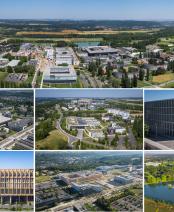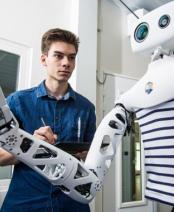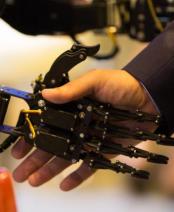Interview with Erik Johnson, expert in photovoltaics

The photovoltaic sector, which offers an alternative to conventional energy sources, has experienced significant growth in recent years. For some people, the sun is an inexhaustible and free source of energy. Do you agree?
Inexhaustible and free, without a doubt. Moreover, the sun provides the Earth's surface with much more energy than human beings need to cover their current needs. On the other hand, human beings are used to working with fossil fuels, which have been accumulating and concentrating over the course of billions of years. They are not used to using solar energy in real time, as we do with photovoltaics (PV). The main challenge is to capture this very dilute energy source, and harness it - by necessity - using arrays of solar panels spread out over huge areas.
What are the pros and cons of photovoltaics?
Photovoltaics has a number of advantages. It is a robust, highly developed, low-carbon technology. The cost of producing solar photovoltaic electricity has decreased dramatically in recent years. The industry can be competitive without subsidies in many parts of the world. Photovoltaic panels can be installed and used in a variety of climates, on urban rooftops, or in dedicated fields. They also do not require huge scales to be efficient. This is not the case, for example, with hydroelectric dams or wind turbines. Moreover, the presence of photovoltaic panels is very well received by the general public nowadays.
As for the disadvantages... Solar energy is abundant, but dilute and intermittent when used directly. It can vary greatly on a monthly, daily, and even on a minute-by-minute scale. The use of PV at large scale requires either energy storage far beyond that which humanity has ever achieved, or preferably, a more intelligent and opportunistic use of energy.
The Laboratory of Physics of Interfaces and Thin Films along with 6 other laboratories at the Institut Polytechnique de Paris, is the project initiator of the PLASMAScience Graduate School (EUR PLASMAScience). What is the LPICM working on in the field of plasma physics? And how are plasmas involved in photovoltaics?
Indeed, our laboratory actively participates in the PLASMAScience Graduate School, which brings together researchers from the Institute Polytechnique de Paris who work in various fields related to plasmas. At the LPICM, we work on plasmas applied to materials.
However, plasmas are only one part of the activities of the LPICM, which is a multidisciplinary laboratory. We conduct fundamental and applied research in the fields of nanostructured and thin film deposition processes, their use in devices (photovoltaic cells, OLEDs, transistors, sensors, batteries, etc.), and spectroscopic instruments to characterize all of this and much more.
As for plasmas, they are omnipresent in photovoltaic manufacturing! For example, in the fabrication of crystalline silicon solar cells (which, when incorporated into modules, make up more than 90% of the panels marketed today), plasmas are used in industrial tools to create passivation and anti-reflection layers, and even layers of doped semiconductors or transparent electrodes for certain technologies.
Researchers and engineers at the LPICM work with plasmas to explore new avenues for photovoltaics or for energy in general. For example, we work to develop innovative processes for depositing thin films for solar cells. Our studies cover different layer morphologies, semiconductor materials (silicon, but also extending to III-V semiconductors), structures (nanowires), or applications (batteries). At the moment, my team is working on a new technique to use a mask-less plasma process to easily fabricate interdigitated back contact solar cells. We believe we have a key solution to increase the efficiency of silicon solar cells and to reduce the manufacturing cost in the industry.
So, you work closely with industry?
Our research has always attracted a lot of interest from industry. In previous years, the LPICM has worked extensively with industry in the field of photovoltaics, sometimes directly, sometimes via consortia in French and European projects. At present, I have a direct collaboration with TotalEnergies through "PISTOL", the ANR Industrial Chair that I hold. The LPICM is also part of the Institut Photovoltaïque d'Ile-de-France (IPVF), a collaboration between the Ecole polytechnique, the CNRS, and several industrial partners (TotalEnergies, EDF, Air Liquide, Horiba, Riber).
Cooperation with industrial partners forces researchers to confront the economic reality of the photovoltaic industry. This can sometimes be frustrating, but at the same time it can push scientists to find new ideas and solutions. This has been the case for me, for example; I had to start thinking differently and consider the effect of costs on the value of my ideas.
What are the challenges in photovoltaics?
The current challenge in photovoltaics is to make more efficient modules at the same cost. We've been through a period of upheaval in the last few years, when the price of a module has dropped so much that a lot of the "cheap" (i.e. not very efficient but not very expensive) technologies, that seemed to be a good solution at the time, don't hold up anymore. So, the goal now is to increase the energy efficiency, without increasing the cost too much, nor reducing the lifetime of the panel. There are more constraints today, but also more pragmatism.
Does this topic attract young people?
Young people are very interested in solar energy. I have the pleasure of teaching a course on photovoltaics at the Ecole polytechnique (PHY558B), so I can testify to the interest of students. The creation of the IPVF has given even more visibility to solar energy research and has made our laboratory even more attractive. As a result, every year we have many applicants (internships, theses) who want to explore this field.
Do you think that young people today are more sensitive to environmental issues than their parents' generations? If so, why do you think that is?
Indeed, I have seen it. My youth was spent in Canada. We were already more aware than our parents of the problems related to the environment, but the actions remained limited: respect nature, recycle, replant trees, don't litter ... We drove around in trucks with V6 4L engines to get to school and back, but we didn't throw anything out the window! However, at the time, global warming was not at the heart of the news.
Today, young people see that the actions of each person to protect the planet are important and beneficial, but that they do not solve the basic problem. They now actively participate in the public debate on the future of the planet, and can discuss the energy transition at a macroscopic scale. This awareness is important among young people, and I am convinced that the scientific community has played a key role in making it so. The vocal warnings of researchers and scientists have brought this information to the attention of the general public and have put the subject on the table, which has then forced our government and industry to react. Go Science!
*LPICM: a mixed research unit, financed and managed by the CNRS, and École polytechnique / Institut Polytechnique de Paris














